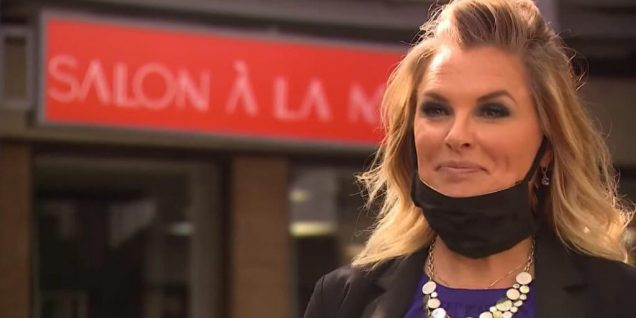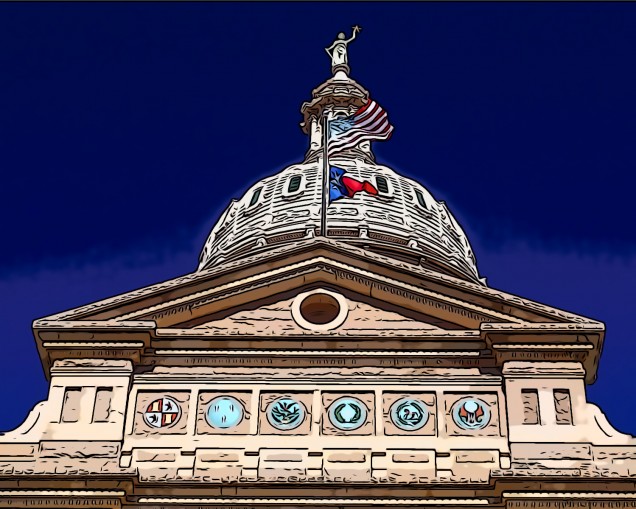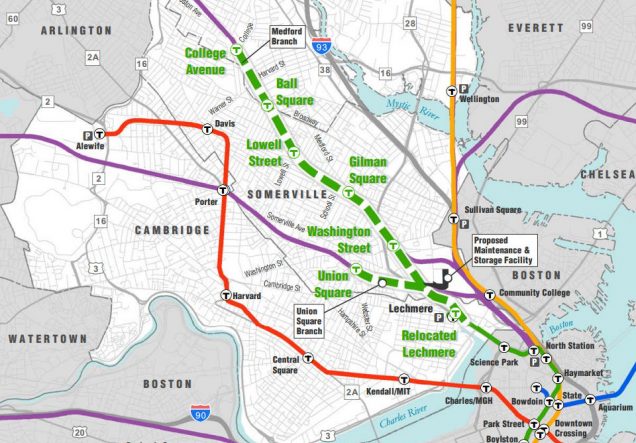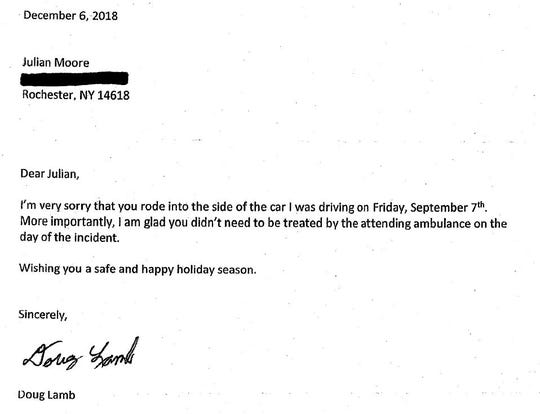Category: State Legislation
Telehealth in the Era of COVID-19 and Beyond
Governor Charlie Baker of Massachusetts has recently issued an Order Expanding Access to Telehealth Services and to Protect Health Care Providers. The order, issued in March, is a public health response to the state’s state of emergency due to the Coronavirus or COVID-19 outbreak. Under the order, the Group Insurance Commission, all Commercial Health Insurers, Blue Cross and Blue Shield of Massachusetts, Inc. and health maintenance organizations regulated by the Division of Insurance are required to let all in-network providers deliver clinically appropriate, medically necessary covered services to their members via telehealth, and to mandate reimbursement for these services. The purpose behind the Order is to encourage the use of telehealth in the mainstream of health care provision, as a “legitimate way for clinicians to support and provide services to their patients.”
Blue Cross and Blue Shield of Massachusetts has recorded over half a million patient telehealth visits over a six-week span and that number is only increasing with time. In comparison, the average number of telehealth visits before the COVID-19 pandemic was 5,000. The demand for health care and medical advice without the requirement of an in-person appointment has soared in light of the outbreak that prevents or prohibits people from attending one due to social distancing guidelines. Prior to the crisis posed by the pandemic and before Governor Baker’s order, hospitals and doctors were disincentivized from offering telehealth visits because health insurers did not cover them or would offer a smaller pay as compared to in-person visits. By introducing payment parity between in-person visits and virtual ones, the order expands access to care as current Massachusetts law allows insurers to limit coverage of telehealth services to insurer-approved health care providers in a telemedicine network.
The arrival of the pandemic and state of emergency has pushed for a rapid expansion of the use of technology in the practice of health care. Many of the barriers to access of health care via telemedicine have shifted in a relatively short period of time. In addition to Governor Baker’s order for payment parity, for example, the Governor allowed health care providers outside Massachusetts to obtain emergency licenses to practice within the Commonwealth. Before this and other similar licensure waivers, licensure requirements usually demand that providers be licensed within the state that their patients reside. By waiving this requirement, providers can expand the network of care they are able to provide, and telehealth serves to eliminate the only other barrier–distance.
 An additional movement towards lifting barriers to the implementation of telehealth services is the relaxation of Health Insurance Portability and Accountability Act of 1996 (HIPAA) noncompliance enforcements by Health and Human Services, with the caveat that providers engage in good faith provision of telehealth during the national health emergency posed by the COVID-19 pandemic. HIPAA rules require the protection of privacy and security of health information. The discretionary enforcement order allows health care providers to use any non-public facing audio or video communication products during the COVID-19 public health emergency. This movement attempts to strike a balance between providing access to care during a national health emergency and the privacy protections against the risk of information exposure that are expected by patients in their interactions with their health care providers.
An additional movement towards lifting barriers to the implementation of telehealth services is the relaxation of Health Insurance Portability and Accountability Act of 1996 (HIPAA) noncompliance enforcements by Health and Human Services, with the caveat that providers engage in good faith provision of telehealth during the national health emergency posed by the COVID-19 pandemic. HIPAA rules require the protection of privacy and security of health information. The discretionary enforcement order allows health care providers to use any non-public facing audio or video communication products during the COVID-19 public health emergency. This movement attempts to strike a balance between providing access to care during a national health emergency and the privacy protections against the risk of information exposure that are expected by patients in their interactions with their health care providers.
Another response to the public health crisis has been issued by the United States Drug Enforcement Agency, notifying that practitioners can, in light of the state of emergency, prescribe controlled substances in the absence of an in-person patient encounter. Prior, the prescription of controlled substances via telehealth evaluation was prohibited entirely. Now, prescribers are allowed to write prescriptions so long as: (1) the prescription is issued for a legitimate medical purpose in the course of the practitioner’s usual professional practice; (2) the telemedicine communication is conducted in a real-time, two-way, audio-visual communication system; and (3) the practitioner is acting in accordance to state and federal law.
As of May 2020, the Commonwealth of Massachusetts has initiated a four-phase reopening plan, beginning with hospitals and community health centers. The East Boston Neighborhood Health Center, for example, has indicated that they have an extensive screening process for patients who head over for in-person appointments, including the use of phone-tracking technology to notify staff when the patient has entered the building in an attempt to streamline entrance to examination rooms. The continued need to introduce methods of facilitating social distancing within the hospitals and community health centers indicates that there will be a continued incentive for the provision of telehealth services. The East Boston Neighborhood Health Center reports that, in the first phase of reopening, they expect 25% of visits to be in-person, with 75% of visits to continue to be via telehealth services such as video chat or over the phone.
While some find telehealth services to be inconvenient, due to technological challenges and care that requires more physical examination than can be completed over the phone or by video calling, it seems likely that we will see a blended version of care into the future. Health care practitioners have indicated that, while telemedicine is not a complete substitution of physically seeing and examining patients, being able to speak with a patient in combination with access to the patient’s medical history goes a long way in being able to diagnose and treat health problems. There is a growing sense of certainty that the use of a technology-based health care experience will “become the new normal.”
The natural question is how the legal landscape will have to adjust in response to the shift as society reopens and the balance of the role of technology in a “new normal” becomes more urgent to strike. Many of the barriers to the expansion of telehealth have been rapidly eliminated as a temporary alleviation in direct response to the public health crisis posed by COVID-19. This indicates that the changes are ephemeral; however, with the uncertainty posed by the length of the pandemic and the resulting impact this will have on the use of technology in health care, it seems likely that some of these legal shifts will need to be modified, rather than entirely eliminated, moving forward.
 Zahraa Badat anticipates graduating from Boston University School of Law in May 2021.
Zahraa Badat anticipates graduating from Boston University School of Law in May 2021.
Checks & Balances in a Pandemic
Recently, Shelley Luther, a Dallas based hair salon owner was jailed for refusing to close down her salon. The owner of Salon à la Mode continued operating her business despite a temporary restraining order last week from Dallas County State District Judge Eric Moyé. She continued operating despite a county official’s cease-and-desist letter ordering her to close.
As Luther faced criminal and civil contempt-of-court charges, Judge Moyé told Luther to admit her actions were selfish and wrong and promise that she would follow the law. CBS DFW reported that Luther refused responding,
“I have to disagree with you, sir, when you say that I’m selfish, because feeding my kids is not selfish. I have hair stylists that are going hungry because they’d rather feed their kids. So, sir, if you think the law is more important than kids getting fed, then please go ahead with your decision, but I am not going to shut down the salon.”
This answer did not please Judge Moyé, who immediately sentenced Luther to seven days in jail. Luther was not given an opportunity to go home or even have a phone call, if it hadn’t had been for her boyfriend her adolescent daughter would not have understood why her mother didn’t come home that night.
During the COVID-19 Coronavirus Pandemic, officials have agreed that jail is a breeding ground for the virus. In order to best protect the people, officials have quickly worked to release many non-violent prisoners for the sake of their health. Dallas county specifically released 1,000 inmates to ease crowding in the hopes to slow the spread of COVID-19 at the Dallas County jail. At a time where officials are releasing prisoners, I find it inappropriate to make an example of Luther by throwing her in jail. Not only was this action a risk to her health, but a risk to her family and those exposed to her when she would be released a week later. Additionally, if Luther had been asymptomatic there was a risk that she herself could have brought the virus into the prison.
Furthermore, Dallas County District Attorney John Creuzot announced policy reforms plans to end mass incarceration in Dallas by decreasing the use of excessively high bail amounts, no longer prosecuting most first-time marijuana offenses and not prosecuting thefts of personal items under $750 that are stolen out of necessity. These policy reforms were established to decrease the number of incoming prisoners. Again, at a time where officials are fighting to decrease prison populations, Moyé’s actions neglected to consider the bigger picture. A better alternative would have been a fine for each day she was in operation, with the money allocated to benefiting the community.
Due to public outcry, Gov. Greg Abbott modified his executive orders to remove confinement as a consequence for violating them. He stated:
“Throwing Texans in jail who have had their businesses shut down through no fault of their own is nonsensical, and I will not allow it to happen,” Abbott said in a statement Thursday. “That is why I am modifying my executive orders to ensure confinement is not a punishment for violating an order.”
His change supersedes local orders and Luther was subsequently released. Luther was fined $7,000 for violating a temporary restraining order against reopening her business. However, Lt. Gov. Dan Patrick pledged to step up and pay the fine on her behalf.
The COVID-19 Coronavirus is an unprecedented time in our nation’s history, with legislators unsure how to best regulate protective measures. State legislators have gained an enormous power with COVID-19 Coronavirus. Without a doubt aggressive government intervention has occurred during this health crisis. Historically, pandemics have led to an expansion of the power of the state. Looking towards the future, legislators will have to work to strike a balance between protective regulations and domineering policies.
 Diana Alexandra Martinez anticipates graduating from Boston University School of Law in May 2021.
Diana Alexandra Martinez anticipates graduating from Boston University School of Law in May 2021.
Funding the MBTA: Getting Derailed Plans Back on Track
Taking the T
The transit system of Eastern Massachusetts, governed by the Massachusetts Bay Transportation Authority, has been the subject of much ire by residents of Greater Boston for decades, particularly where the subway, or “T,” is concerned. A prime example is last year’s decision to raise fares by 6% despite continual failures in service, such as a recent derailment on the Red Line and power shutdown on the Blue Line. As the oldest subway system in North America, many of the T’s problems stem from decades- or even century-old design decisions which are impractical to redo today. For example, its hub-and-spoke layout emphasizes access to downtown Boston at the expense of ease of travel between the edges of the system.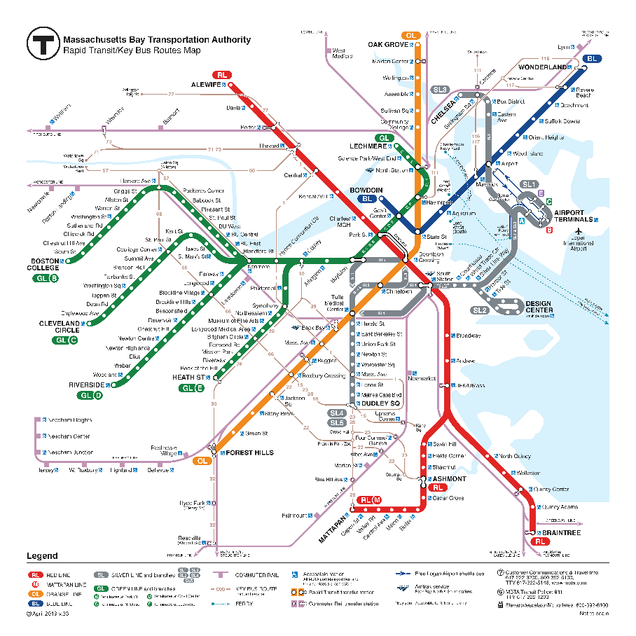
Broke, But Not Broken
However, the primary barrier to the T being the efficient, functional transit system that Boston needs it to be is insufficient funding relative to necessary maintenance and upgrades, not to mention its current debt load. Though the MBTA system as a whole sees more than $2 billion in annual revenue, it still endures annual operating losses of more than $36 million. Significantly, the majority of its revenue does not come from operations, i.e. fares collected, but rather from sales tax and local assessment contributions. For nearly twenty years, a “penny” of all non-meal-and-drink sales tax revenue in Massachusetts has been dedicated to the MBTA budget. Because this source of tax revenue has not grown as anticipated, the MBTA budget has consequentially fallen short of expectations by well over $200 million per year. Meanwhile, costs of new projects continue to balloon. The cost of an upgraded fare collection system, originally budgeted at just over $700 million, has now grown to over $900 million.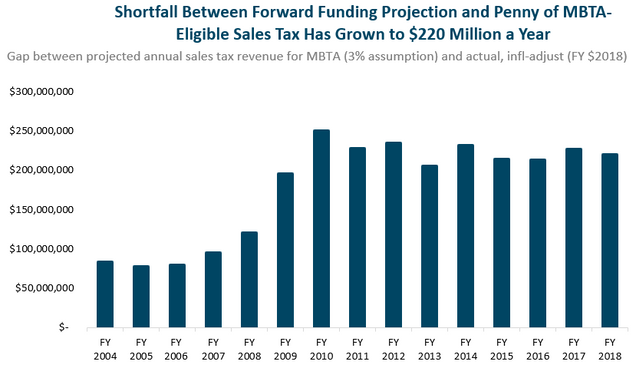
Boston City Councilor Michelle Wu argues that incremental fixes and patching of problems is insufficient; rather, we must invest in the system as a whole with a focus on expanding access. The necessity of serious capital investment became especially apparent after historic blizzards in early 2015 forced a system-wide shutdown. Wu has pointed to Governor Charlie Baker’s reluctance to act as an obstacle to the requisite overhaul the T needs. In response to pressure from her and other transit advocates, last summer Gov. Baker announced plans to accelerate an ongoing five-year, $8 billion capital investment program which kicked off in early 2019. The program aims to provide new rapid-transit buses and train cars, modernize the Red and Orange Lines, and fund a major expansion of the Green Line into underserved areas of Somerville and Medford. The latter, a long-suffering project decades in the making, is an example of the importance of major investment in transit: once complete, the percentage of Somerville residents within walking distance to light rail will increase to 80%, up from a current 20%. Gov. Baker’s acceleration includes more aggressive closures to allow for infrastructure work, more inspections and maintenance, negotiations with contractors, and the creation of a new team of MBTA personnel with the flexibility to work on multiple projects.
Capital Infusions
Even so, continued problems, such as the aforementioned Red Line derailment, prompted Gov. Baker to propose an $18 billion bond bill for transportation throughout the Commonwealth last year, providing money to the entire Massachusetts Department of Transportation, including a $5.7 billion slice for the MBTA. This bill, An Act Authorizing and Accelerating Transportation Investment, most recently received approval, with an amendment, from the House Committee on Bonding, Capital Expenditures and State Assets and moved before the House Committee on Ways and Means in late February, 2020. This Act would fund road and bridge repairs, MBTA upgrades, and the electrification of regional transit services, as well as contribute to big projects such as Cape Cod Canal bridges and the Green Line Extension. The bill also provides support for improving pavement on public roads and building small bridges as well as help for municipalities seeking to make their roads more cyclist- and pedestrian-friendly. Other provisions aim to reduce traffic congestion and greenhouse gas emissions by building bus lanes and working to reduce bottlenecks. Transportation Secretary Stephanie Pollack highlighted the importance of action on other projects which complement improved transit service to maximize the impact of the bill. Such legislation includes Gov. Baker’s proposed Housing Choices Act, which would streamline zoning approval for certain housing projects.
This past January, Gov. Baker also proposed a $135 million budget increase for the MBTA, possibly in response to a scathing December 2019 report by the Safety Review Panel which found deficiencies “in almost every area” of the MBTA system. A major criticism was the recent over-emphasis on capital improvements and not enough support for regular maintenance and safety, with staff being diverted away from the latter. However, it is unclear how exactly the infusion of funding would be spent.
It should be noted that there currently remain $743 million in outstanding senior revenue bond loans to MassDOT, though the Department maintains an A+ rating for borrowing. Though the Act Authorizing and Accelerating Transportation Investment would be funded by further borrowing via bonds, its original version allocated half of all revenue from a potential greenhouse gas cap-and-trade program with other states in the region to public transit, creating a stream of revenue as well as encouraging more fuel-efficient cars. However, that provision was stricken by the Transportation Committee, which argued that they cannot allocate funds to a program that does not yet exist. Lawmakers instead plan to increase fees on transportation network companies and deeds excise taxes.
COVID-19 Crisis
The amendments, including those made earlier by the House Committee on Transportation, include the elimination of $50 million in business tax cuts to encourage employees to work from home and thus reduce traffic congestion, a quaint decision in the midst of the COVID-19 pandemic which has forced millions to work from home anyway. The MBTA has been understandably hit hard, and as of April, ridership on the T was down more than 90% from late February, with bus service down nearly 80%. Anticipated losses this year exceed $213 million due to a 95% plunge in fare collection and drops in revenue from advertising and state sales tax. MassDOT hopes to cover the loss with an expected infusion of $840 million in federal funds through the CARES Act. Meanwhile, the MBTA has reduced service, instituted cleaning and sanitizing regimes for vehicles, and has begun requiring employees and remaining riders to wear face masks.
Needless to say, major investment decisions as of this writing have been put on hold. However, once this crisis has passed, it is critical that Massachusetts act to ensure its transit services remain a functional asset to the people of the Greater Boston Area and beyond.
 Kellen Safreed anticipates graduating from Boston University School of Law in May 2021.
Kellen Safreed anticipates graduating from Boston University School of Law in May 2021.
How We Gonna Pay Last Year’s Rent?* Advocating Rental Housing Reform in Boston
*Adam Pascal et al., Rent, on, Rent Original Major Picture Soundtrack (Warner Records 2005).
Unprecedented Rental Relief in Unprecedented Times
The novel coronavirus is disrupting so much of life in Boston, MA. From school and business closings to rising unemployment rates, more residents than ever are concerned than ever with affording basic essentials—including the rent due on the first of each month. The reality of how to pay for rent is substantial in Boston, where an estimated sixty percent of over seven-hundred thousand residents rent, making it the fourth most densely populated region in the United States after the New York Metro Area, Greater Los Angeles, and South Florida Metro Area.
As of April 20, Gov. Charlie Baker signed legislation placing a moratorium on non-emergency residential evictions and foreclosures during the novel coronavirus pandemic. Under this moratorium, landlords are not able to file eviction notices for the next 120 days, or for 45 days from the lifting of Gov. Baker’s emergency declaration, whichever comes first. Additionally, the moratorium bans late fees and negative reporting to credit-rating agencies for unpaid rents if tenants can prove pandemic-related issues with late payments.
Figure 1: Baker signs bill blocking evictions during coronavirus crisis (Tim Logan, Baker signs bill blocking evictions during coronavirus crisis, Boston Globe (Apr. 20, 2020))
Additionally, the federal government has passed a $2 trillion coronavirus rescue package—the CARES Act—including a 120-day moratorium on most evictions at properties that receive federal subsidies or that federal entities insure. Notably, the CARES Act does not apply to eviction proceedings in progress before President signed the legislation on March 27th, or to eviction cases meeting a number of exceptions discussed in the Act.
On April 4, Mayor Martin Walsh announced $3 million in city funds to help Boston residents at risk of losing their rental housing due to the novel coronavirus pandemic. The Rental Relief Fund is managed by the Office of Housing Stability, in partnership with non-profit partners Metro Housing Boston and Neighborhood of Affordable Housing. This program will provide eligible applicants with up to $4,000 in financial assistance to be used for rent. Additionally, the funding will only be available to households earning less than 80 percent of Area Median Income (AMI), which is $72,000 for a two-person household. A significant portion of these funds are reserved for households with extremely low incomes (under $25,000 for a single-person household), and very low-incomes or less than $42,000 for a single person (50 percent AMI). "In the midst of the COVID-19 pandemic, a national crisis at a scale not seen in our lifetime, it is imperative that all levels of government exercise all possible tools to ensure the health and safety of our residents, and to keep them stably housed," said Mayor Walsh. (Thomas Stackpole, How Did Renting in Boston Become Such a Nightmare?, Boston Magazine (May 30, 2020))
The Rent is Due Every Day: Framework Changes to the Rental Housing Market
The efforts of the federal and MA government to address the needs of renters in Boston are necessary measures to help residents maintain stable housing in these unprecedented times. Nevertheless, it is merely band-aid for the greater problem of the daily struggle for low-income Boston residents to make rent, or even establish tenancies.
The Commonwealth provides financial assistance through the Residential Assistance for Families in Transition (“RAFT”) program in which up to $4,000 may be awarded to applicants to establish tenancies. However, with Fair Market Rent (“FMR”) rising in Massachusetts to $1,425 for a one-bedroom and $1,758 for a two-bedroom apartment, the $4,000 allocation from the RAFT program may not be enough to overcome the high bar to starting tenancies in Massachusetts for low-income families who are homeless or at risk of becoming homeless. The barriers to entry establishing a tenancy in MA include: the first full month of rent, last full month of rent, security deposit equal to the first month’s rent, broker fee equal to first month rent, and one-time fee covering installation of a new key and lock. The cumulative effect of these fees requires upwards of four months of rent to gain tenancy in Massachusetts. The impact of this legislation disproportionately bar low-income residents from securing and maintaining affordable housing.
When federal and state aid to low-income residents is not sufficient to help families begin tenancies, it is imperative to look to alleviating some of these barriers to entry to affordable housing. In addition to being the fourth most densely populated region in the United States, Boston also is also boasts the fourth-highest average rental market. Compared to the rental markets of New York City and Los Angeles, the Boston market imposes the broker fee, equal to one full month’s rent, which may be borne by the tenant. This differs to New York’s recent ban on broker fees, and Los Angeles’ burden shifting of broker fees to the landlord.
Massachusetts should consider following in the footsteps of their metropolitan neighbors and propose legislative action banning broker fees in order to decrease the burden to tenants establishing tenancy. In the alternative, the legislature should support the proposed bill H.4452: An Act Relative to Consumer Rights of Renters which shifts the burden of paying broker fees to the landlord with the following language: “[t]his fee shall only be paid by the lessor of the residential dwelling and shall not be transferred to or paid by an other party.”
Conclusion
The novel coronavirus is truly a pandemic affecting every area of daily life, but it’s disparate impact to low-income families towards their struggle to afford housing illuminates a deeper issue that needs to be addressed with expediency. The cost of securing and maintaining a tenancy in Boston is simply too high and not sustainable. As a result, the legislature should tackle broker fees directly to allow more residents the opportunity to initiate affordable tenancies in Boston. This may take the form of eliminating broker fees in their entirety, or shifting the burden to landlords to pay the fee, but ultimately the legislature should take action to protect the most vulnerable member in this time—low-income residents trying to establish and maintain affordable housing for themselves and their families.
 Alexandra Trobe anticipates graduating from Boston University School of Law in May 2021.
Alexandra Trobe anticipates graduating from Boston University School of Law in May 2021.
To Combat Adolescent Tobacco Use, Federal Law Raises Purchasing Age to 21
In the final weeks of 2019, in the wake of an outbreak of vaping-related illnesses and death, the federal government raised the minimum age of tobacco sales from 18 to 21. The widely-supported amendment to the Food, Drug, and Cosmetic Act was included in an appropriations bill that Congress approved on December 19th and President Trump signed into law the next day. The new law makes it illegal to sell tobacco products, including electronic cigarettes/vapes, to anyone under the age of 21 throughout the United States. While the law is a positive step for public health, it is long overdue and lacks much needed enforcement enhancement measures.
The federal government followed in the footsteps of 19 states, Washington D.C., and hundreds of local governments which had already increased the tobacco age to 21. The push to increase the tobacco age is referred to as the Tobacco 21 movement. The first Tobacco 21 law was enacted in Nedham, Massachusetts in 2005. In 2013, New York City became the first major city to pass a Tobacco 21 law. The wave of state-level Tobacco 21 laws began in 2016 with Hawaii and California, and continued with
Washington and New Jersey in 2017, Oregon, Maine and Massachusetts in 2018, Virginia, Illinois, Delaware, Arkansas, Maryland, Vermont, Texas, Connecticut and Ohio in 2019, and Washington, Utah, Pennsylvania, and South Dakota in 2020. New Mexico is the latest state to pass a tobacco 21 law which will go into effect in 2021.
The Tobacco 21 movement is supported by a strong foundation of research demonstrating the importance and efficacy of raising the age. In the Surgeon General’s 2012 report on Preventing Tobacco Use Among Youth and Young Adults, the epidemiological research showed that “adolescence and young adulthood represent[s] a time of heightened vulnerability to tobacco use and the initiation of cigarette smoking.” The rationale behind increasing the age from 18 to 21 is to reduce the number of people who begin smoking (or vaping) by making it more difficult to access tobacco during the years of highest vulnerability. And studies show that 98% percent of smokers begin before 26 years old and 90% of daily cigarette use begins before 20 years of age. Raising the age not only makes it more difficult for 18-20 year-olds to purchase tobacco, it also reduces access for minors who often rely on friends who are 18 and older to purchase tobacco products for them. In fact, it is estimated that “90% of persons who purchase cigarettes for distribution to minors are under 21.”
 In addition to conventional cigarettes and tobacco products, Tobacco 21 laws also prevent people under the age of 21 from buying electronic cigarettes or vapes. This is because electronic cigarettes are deemed to be tobacco products by the FDA. Electronic cigarettes are the most commonly used tobacco products among youth today, and a 2018 study showed that 1 in 5 high school students and 1 in 20 middle school students use these products. Those numbers were likely even higher in 2019 when the mysterious vaping illnesses, which prompted this legislation, began. Even before the outbreak, the high rate of electronic cigarette use among American youth was troubling. Not only were public health officials warning of the known harms associated with vaping (such as potential for lung damage, and dangers of nicotine consumption for brain development), but also the universe of unknown risks associated with vaping as these products are relatively new and rapidly changing.
In addition to conventional cigarettes and tobacco products, Tobacco 21 laws also prevent people under the age of 21 from buying electronic cigarettes or vapes. This is because electronic cigarettes are deemed to be tobacco products by the FDA. Electronic cigarettes are the most commonly used tobacco products among youth today, and a 2018 study showed that 1 in 5 high school students and 1 in 20 middle school students use these products. Those numbers were likely even higher in 2019 when the mysterious vaping illnesses, which prompted this legislation, began. Even before the outbreak, the high rate of electronic cigarette use among American youth was troubling. Not only were public health officials warning of the known harms associated with vaping (such as potential for lung damage, and dangers of nicotine consumption for brain development), but also the universe of unknown risks associated with vaping as these products are relatively new and rapidly changing.
The vaping illness outbreak began in August 2019, when vaping product users— including many teens—suddenly began presenting to emergency departments with severe lung injuries. By December 4th, the Centers for Disease Control and prevention had confirmed over 2,200 cases and 48 deaths related to the outbreak. The reason for the sudden increase in vaping related illness was not immediately clear, and it stirred up panic among parents of teenagers and mobilized public health professionals who had long feared the harmful effects of vaping.
With the outbreak capturing the nation’s attention, Congress and the Trump administration were under pressure to do something to address the problem. With such powerful momentum in the Tobacco 21 movement, public health advocates and policy makers had already began calling for a federal Tobacco 21 law years ago (read more about that here, or here). Passing a federal Tobacco 21 law to address the vaping illness outbreak was an easy choice because, in contrast to more drastic measures such as banning electronic cigarettes entirely, raising the age enabled Congress to respond to the fear and public outcry surrounding the vaping illnesses in a manner that was actually supported by tobacco and vaping companies. While some advocates feel that raising the age was not a drastic enough measure to combat the vaping epidemic, it is certainly a positive step for public health and to combat tobacco consumption generally.
While the new law will make it more difficult for those under 21 to access tobacco products, the efficacy will depend largely on proper enforcement of the law. Enforcement of age restrictions on tobacco purchasing has been demonstrably poor, with many retailers still selling tobacco products to minors before the new law became effective. While amending the FDCA, Congress could have used this opportunity to not only raise the tobacco age but also to ramp up the enforcement mechanisms contained within the Act, by increasing funding, penalties or requirements on the number of compliance checks. Unfortunately, that did not occur and the new law. Without a change in the law to effectuate stricter enforcement measures, it will be difficult for the federal and state governments to oversee enforcement of the law and to make sure that retailers properly comply.
The federal Tobacco 21 law is a bittersweet victory for public health champions who have been warning against the risks of vaping and campaigning for an increase in the tobacco age since long before the mysterious vaping illnesses began. In order for our tobacco laws to truly be successful, our legislators must increase enforcement and properly fund measures that prevent the initiation of tobacco use. As with all areas of public health, we must act to prevent —not just respond once crises have already begun.
 Rebecca Mashni graduated from The Ohio State University in 2015 with a B.S. in Public Health and graduated from Boston University School of Law in May 2020 with a J.D.
Rebecca Mashni graduated from The Ohio State University in 2015 with a B.S. in Public Health and graduated from Boston University School of Law in May 2020 with a J.D.
Supplying Housing Demand: Gov. Baker’s Proposed Housing Choices Act
There is no question that Massachusetts generally, and the Boston area in particular, is mired in an affordable housing crisis. Renters and would-be buyers are heavily burdened with disproportionate housing costs and are forced to compete for a limited supply of units. As of 2019, Massachusetts rental costs climbed to the third highest in the nation, surpassed only by California and Hawaii, making this the rare occasion in which beating New York isn’t something to celebrate. To increase housing, the state must address the burdensome rules that hinder the development of new units; especially multifamily homes. One possible solution is the proposed Housing Choices Act.
Though there are many facets to this issue and no simple solution, Gov. Charlie Baker is focusing on attacking the restrictive zoning rules and arduous permitting processes. Gov. Baker argues these rules are causing shortfalls in housing stock, driving up prices as demand far outstrips supply. Gov. Baker’s bill, the Housing Choices Act, was stalled throughout 2019, until late December when it was referred to the House committee of Ways and Means.
The Act has garnered the support of organizations such as the Boston Medical Center, Real Estate Bar Association, Massachusetts Municipal Association, Massachusetts Association of Community Development Corporations, Metro Housing Boston, and many more.
Gov. Baker’s administration has set a target of building 135,000 new housing units by 2025 and the Governor believes rezoning to allow more multifamily construction is a key piece in increasing housing production. Since 2017, Gov. Baker’s Housing Choices Initiative has incentivized municipalities to help meet this target by providing grants to support housing construction, but access to those grants still requires communities to vote in favor of rezoning. The Housing Choices Act would simplify rezoning by reducing the threshold of votes needed to pass certain kinds of progressive, production-oriented zoning changes in Massachusetts municipalities from two-thirds to a straight majority vote. Massachusetts is among the few states which require a supermajority for these kinds of zoning votes. The Governor calls the Housing Choice Act a “critical” piece of legislation in pursuit of production goals because it will ease that rezoning process.
Among the zoning changes to which the new straight majority vote would apply are the adoption of “smart-growth” districts under Ch. 40R, which governs…. “Smart growth” includes the construction of multi-family buildings, special permits for high-density construction, the reduction of size and parking requirements, transit-oriented projects with a set percentage of affordable units, and permission to construct accessory dwelling units.
Criticism: Too Narrow or Too Broad?
Critics such as Darnell Johnson, regional coordinator at Right to the City Boston, however, believe that the bill “ignore[es] the needs of working families” and will only lead to more luxury condos and other housing out of reach for most Massachusetts residents. Chris Norris, executive director Metro Housing Boston, concurs, and points out that with 250,000 low-income households forced to spend upwards of 50% of their income on rent, “incentives alone are not sufficient to product affordable housing.” Norris cites the fact that Ch. 40R was passed in 2004, was expected to generate 33,000 new units over ten years, and more than $20 million has been poured into its incentives. As of 2017, however, this law has produced only 3,500 units, less than half of which are designated as affordable.
Advocates within and without the Baker administration counter that this bill is not meant to be a panacea for housing woes but rather a step in the right direction. Clark Zeigler, executive director of the Massachusetts Housing Partnership, points out that right now good housing proposals are defeated despite winning majority support because of the current two-thirds voting requirements. Such was the case in Salem, where a measure to increase accessory dwelling units, one of the Housing Choice Act’s targets, won the majority, but not supermajority, and thus failed to pass. Salem Mayor Kim Driscoll supports Gov. Baker’s efforts to prevent situations like this, calling on local authorities to pursue a “strong partnership with state leaders.” Once this problem is solved, MHP and other affordable housing advocates can and will continue pushing for further means of providing relief to those overly burdened by housing costs. In an official statement, CHAPA (Citizens’ Housing and Planning Association) made its support of the Housing Choice Act clear for the same reasons. “Lowering the super majority threshold required for zoning changes will empower the simple majority of people in a community to vote ‘Yes’ for housing.” CHAPA sees the bill as an essential opportunity to help communities “encourage housing development and undo policies that prevent housing production and perpetuate segregation.”
Another source of criticism is a fear that the bill would inevitably cause unwanted and overly dense construction which will damage the character of older neighborhoods. Similarly, Rep. Smitty Pignatelli (D-4th Berk.) proposes that the switch to straight majority be predicated on local approval out of concern for state-level infringement on local autonomy. Sen. Brendan Crighton (D-Lynn), co-chairman of the Housing Committee, does not believe this is a real cause for concern, insisting that the bill “doesn’t take away any local control. . . [but rather] puts together a more common-sense approach that says a majority of folks can make a decision on the matter.” He sees this and similar legislation as crucial because Massachusetts’ housing production is half of what it was in the 1970s while rent has risen by 75% over the past twenty years.
Some communities, such as Needham and Springfield, believe they and some 70 other municipalities should be exempt from the bill because 10 percent or more of their housing stock already meets state “affordability” thresholds. Needham Select Board Chairman John Bulian sees requiring his town to comply would be penalizing it despite its having exceeded Massachusetts’ affordable housing percentage goals. Such complaints, however, seem to miss the larger picture of spurring more housing growth by enabling local residents greater control over their zoning through simplified zoning vote processes.
Massachusetts is in a housing crisis—one that can only be fixed by finding a way to build more housing. An important first step is to reform the rules and processes that restrict the needed housing units.
 Kellen Safreed anticipates graduating from Boston University School of Law in May 2021.
Kellen Safreed anticipates graduating from Boston University School of Law in May 2021.
Protecting Vulnerable Road Users: A Vicious Cycle
Ten-year-old, Julian Moore was riding his bicycle in a suburb in Rochester, NY on Sept. 7, 2018, when 66-year-old Doug Lamb hit him with his Range Rover.

Figure 1: Julian Moore and his mother, Jenny Moore, walk near the spot where Julian was hit while bicycling. (Photo: Max Schulte/Rochester Democrat and Chronicle).
Lamb stopped the car after his collision with Moore, but did not give his information to Julian, the paramedics, or Julian’s mother. By the time the police arrived, Lamb had departed the scene. It took two weeks for the police to track Lamb down and charge him with the misdemeanor crime of leaving the scene of an accident causing personal injury. Pittsford Town Judge John Bernacki had decided to adjourn the case in contemplation of dismissal, meaning Lamb’s record would be wiped clean, on the condition that Lamb write an apology to the boy.
His apology letter read:
This act of “contrition” drew sweeping public scorn in January after the boy’s mother, Jenny Moore, posted a copy of the letter on her Facebook Page and the backstory subsequently made headlines around the country. In response, prosecutors moved to re-open the case and proceed to trial for failing to meet the apology requirement of his plea deal.
Prosecutor Daniel Strollo said his office pursued the case to the extent that it did because Lamb neglected to meet the condition to which he agreed to resolve the matter. “Mr. Lamb was given one simple instruction: to send a letter of apology,” Strollo said. “He didn’t do that. When you don’t follow through on the terms of a commitment for a plea or a disposition of a case, our office is not going to just ignore it.”
Lamb plead guilty on Dec. 6 in Pittsford Town Court to leaving the scene of an accident causing property damage—a mere traffic infraction. In exchange, Lamb was ordered to pay a $200 fine, perform eight hours of community service.
Julian’s story garnered national attention for his crash. Lamb was protected by a 5,000-pound vehicle of steel. Julian was protected by a plastic helmet. If it seems ludicrous the legal system could enable Lamb to walk away with a small fine and apology, it may be time to even the playing field and shift legislative protections toward vulnerable road users such as Julian.
Vulnerable Road Users
All over the country, thousands of similar crashes are occurring in the shadows, without the benefit of a national audience holding drivers accountable. The National Highway Traffic Safety Administration data shows 857 cyclists were killed in crashes with vehicles the U.S. in 2018. The same study found Florida leading the country with 161 of those fatalities, finding bicycle deaths for those 20 and older have tripled since 1975.
However, Florida legislators are prepared to step up and do something about the mounting problem, formally adopting “Vision Zero Florida” with a strategic goal of zero traffic fatalities and severe injuries for all users. Part of this vision includes advocacy for a proposed bill, H.B. 455 – Traffic Offenses, in the Florida Legislature which provides criminal penalties for persons committing moving violations causing serious bodily injury or death to a vulnerable road user including: a fine, period of house arrest, mandatory driver education, revocation of driver license. One of the largest shifts however, is the establishment and definition of “vulnerable road user.”
The League of American Bicyclists, a national bicycle advocacy organization, defines a Vulnerable Road User (“VRU”) as “anyone who is on or alongside a roadway without the protective hard covering of a metal automobile. The term includes bicycle riders, pedestrians, motorcyclists, people in wheelchairs, police, first responders, roadway workers and other users like a person on a skateboard or scooter. It is meant to include people who are especially at risk of serious bodily harm if hit by a car, or truck.”
VRU laws operate on the principal of general deterrence - by providing an increased penalty for certain road behaviors that lead to the serious injury or death of certain road users people will be deterred from doing those behaviors around those users.
In 2007, Oregon became the first Legislature to pass, HB 3314, creating an enhanced penalty for careless driving if it contributes to serious physical injury or death to a “vulnerable user of a public way.” Currently, only nine 9 states have laws that define a vulnerable user or VRU and provide particular penalties for actions towards those vulnerable road users or when violations of traffic law lead to the serious injury or death of a VRU – Connecticut, Delaware, Florida, Hawaii, Maine, Oregon, Utah, Vermont, and Washington. In Texas, approximately 28 cities have passed their own VRU laws in the absence of a statewide version.
To advance this legislative effort, the League of American Bicyclists, proposes a model VRU statute for state legislatures. The model language: Section 1) defines VRU protected persons; Section 2) defines when the law is applicable and who can be charged with a violation of the law; Section 3) requires a person charged according to this law to attend a hearing; and Section 4) provides the punishments that are to be given to a person convicted of a violation of this law.
Road Ahead
Without enhanced protection for VRUs through increased penalties, it is common for a driver who kills or seriously injures a VRU to just be given a ticket for careless driving, as illustrated in a 2013 report by the Center for Investigative Reporting finding that in 238 pedestrian fatalities 60% of motorists found to be at fault or suspected of a crime faced no criminal charges.
As the closing lines of Prosecutor Strollo’s motion on behalf of Julian Moore states, “[t]he people are ready for trial.” Echoing a crystalizing national awareness that calls for increased protections to vulnerable road users, the people are ready for legislative change—and states legislatures should consider adopting a version of the VRU model law to meet this demand.
 Alexandra Trobe anticipates graduating from Boston University School of Law in May 2021.
Alexandra Trobe anticipates graduating from Boston University School of Law in May 2021.
The Fight for LGBTQ+ Justice and the Equality Act
Throughout American history, the LGBTQ+ community has continually faced unconscionable levels of harassment, discrimination, and vitriol; Congress cannot waste another session without passing the Equality Act into law.
Discrimination against the community is pervasive; LGBTQ+ Americans have reported harm to their mental health (69%), physical well-being and safety (45%), school environment (39%), work environment (53%), and relationships with their neighbors and local communities (57%). More than half of LGBTQ+ Americans have faced discrimination by healthcare providers. In surveys, LGBTQ+ Americans admit to using vague language about relationships (42%), refusing to talk about their partner (37%), hiding affiliations to LGBTQ+ groups (15%) and avoiding discussion of LGBTQ+ issues altogether (31%) out of fears of facing harassment and other damaging bigotry. Additionally, LGBTQ+ people have often changed the way they dress (15%), changed the way they talk (15%), cut important people out of their lives (16%), and moved away from their families (17%) because of the harmful consequences of discrimination.
Furthermore, transgender Americans face a disproportionate share of violence and discrimination – even compared to other members of the LGBTQ+ community. 33% of trans Americans have been denied equal services or physically attacked when visiting a place of public accommodation (like a hotel, restaurant, or government office). 27% of trans workers have been fired, not hired, or denied a promotion because of their gender. Additionally, 25% have been refused treatment or physically assaulted by their primary physician, health clinic, or hospital due to their gender identity – despite new Affordable Care Act regulations that were written with the specific intention to prohibit such discrimination against trans Americans by federally-funded providers. Members of the trans community have reported avoiding public transportation (11%), stores and restaurants (26%), and going to the doctor (24%) for fears of facing abuse and violence.
Queer people face high rates of discrimination and violence because of state and federal inaction. In twenty-nine states, LGBTQ+ Americans can be fired from a job, evicted from their home, or denied a line of credit because their employer, landlord, or bank disapproves of their sexual orientation or gender identity. In fourteen states, there is no ban on LGBTQ+ discrimination in schools. Clear and universal legal protections for LGBTQ+ Americans are desperately needed if our country is ever going to heal the evils that have been done for generations against our vulnerable population.
Therefore, Congress must pass a bold LGBTQ+ civil rights bill – such as the Equality Act sponsored by Representative David Cicilline (D-RI). This legislation would amend the Civil Rights Act of 1964 to protect Americans from discrimination based on “sex, sexual orientation, gender identity, or pregnancy, childbirth, or a related medical condition of an individual, as well as because of sex-based stereotypes” in federal funding, education, housing, employment, credit access, jury service, and public accommodations. It covers claims based on: (1) association with another member of a protected class; or (2) a perception or belief, even if inaccurate, that someone is a member of that class. The Act would expand “public accommodations” to include “any establishment that provides a good, service, program,…health care, accounting, or legal services,” or “any…transportation service.” Furthermore, the Act prohibits denying individuals access to a “shared facility” (restroom, locker room, dressing room, etc.) in accordance with their gender identity. Finally, the bill allows the Justice Department to bring these claims in federal court, and prohibits anyone who violates the Equality Act from asserting protection under the Religious Freedom Restoration Act of 1993 (RFRA) as a valid defense to discriminating against LGBTQ+ Americans.
 The Equality Act would be a crucial step forward for America. First, the bill expands protections under the Civil Rights Act of 1964 for all protected classes under the law, not just the LGBTQ+ community. For example, the bill would extend the Civil Rights Act’s current ban on discrimination based on sex to also cover public accommodations, state and local government services, and federal funding. Second, this bill would enact into federal law stronger anti-discrimination protections for the LGBTQ+ community than even the most liberal possible Supreme Court decisions could provide through Bostock v. Clayton County, Georgia (whether discrimination against an employee because of sexual orientation constitutes prohibited employment discrimination “because of . . . sex” within the meaning of Title VII of the Civil Rights Act of 1964, 42 U.S.C. § 2000e-2) or R.G. & G.R. Harris Funeral Homes Inc. (whether Title VII prohibits discrimination against transgender people based on (1) their transgender status or (2) sex stereotyping under Price Waterhouse v. Hopkins) this summer.
The Equality Act would be a crucial step forward for America. First, the bill expands protections under the Civil Rights Act of 1964 for all protected classes under the law, not just the LGBTQ+ community. For example, the bill would extend the Civil Rights Act’s current ban on discrimination based on sex to also cover public accommodations, state and local government services, and federal funding. Second, this bill would enact into federal law stronger anti-discrimination protections for the LGBTQ+ community than even the most liberal possible Supreme Court decisions could provide through Bostock v. Clayton County, Georgia (whether discrimination against an employee because of sexual orientation constitutes prohibited employment discrimination “because of . . . sex” within the meaning of Title VII of the Civil Rights Act of 1964, 42 U.S.C. § 2000e-2) or R.G. & G.R. Harris Funeral Homes Inc. (whether Title VII prohibits discrimination against transgender people based on (1) their transgender status or (2) sex stereotyping under Price Waterhouse v. Hopkins) this summer.
Finally, public opinion strongly supports passage of federal LGBTQ+ protections. 79% of Democrats, 56% of Republicans, and 70% of Independents polled in 2018 supported passage of non-discrimination laws to protect members of the LGBTQ+ community. This support includes a majority in every age group – from millennials to the elderly – and even includes a majority of white evangelical Protestants, a group that typically has conservative positions on social issues. Outside of polls, there are also a number of powerful interest groups supporting passage of the Equality Act. Such groups include civil rights organizations (ACLU, Anti-Defamation League, NAACP, AARP), women’s rights groups (NOW, CLUW), corporations (Visa, Mastercard, Apple, Google, Netflix, Microsoft, Amazon, eBay, IBM, Facebook, Airbnb, Twitter, Intel, American Airlines), medical and professional organizations (AMA, APA, ABA, National PTA), unions (CWA, SEIU, AFSCME, AFT), celebrities (Karamo Brown, Nyle DiMarco, Adam Rippon, Jesse Tyler Ferguson, Taylor Swift), and religious organizations (Episcopal Church, United Methodist Church, United Church of Christ, Evangelical Lutheran Church in America, More Light Presbyterians, United Synagogue of Conservative Judaism, Muslims for Progressive Values, Hindu American Foundation, Unitarian Universalist Association).
The Equality Act is certainly not perfect. An ideal bill would attack not just de jure LGBTQ+ discrimination, but also de facto discrimination caused by implicit biases and socioeconomic disparities. Such a law dedicated to establishing LGBTQ+ justice might: 1) specifically include HIV/AIDS status as a class of protected individuals covered by the Equality Act; 2) expand federal funding for Medicaid, public health clinics, mental health coverage, and combatting youth homelessness; 3) ensure all homeless shelters and rehabilitation centers receiving federal funds are LGBTQ+ affirming; 4) bolster protections against hate crimes, gun violence, and the targeting of LGBTQ+ populations by law enforcement; 5) require all private and public insurance plans to cover HIV prevention; 6) require school districts that receive federal funds to adopt sex education programs that are comprehensive and LGBTQ+ inclusive; 7) institute codes of conduct prohibiting bullying and harassment in our public schools; and 8) prohibit LGBTQ+ conversion therapy. However, under the current limitations of today’s Congress, the Equality Act seems a good first step towards building a broader movement for LGBTQ+ justice over the next decade.
Although polling shows that most Americans do not think “religious objections should be a reason to deny service to an LGBTQ person” in business (57%), healthcare (64%) or employment (62%), a recent Reuters poll found that only 23% of Americans know that federal LGBTQ+ protections haven’t been enacted yet. Given the high popularity of the Equality Act, and the even higher need for its invaluable protections, Congress must finally pass this vital civil rights bill into law. The lives of LGBTQ+ men, women, and children across the United States are at stake.
 Samuel Shepard graduated from Boston University School of Law in May 2020.
Samuel Shepard graduated from Boston University School of Law in May 2020.
Electric Scooters and Data Reporting: A Roadmap to Smart Development
In many cities electric scooters appeared virtually overnight. These new forms of transportation have many benefits including: decreasing carbon emissions, making public transit more accessible, and solving first/last mile issues. Scooters also exacerbate many issues facing urban planners: taking up space on sidewalks, scaring pedestrians, increasing congestion, and may decrease public transit revenues. As state and municipal authorities scramble to regulate this new popular transportation mode, they should also embrace the benefits. A needed first step is to repurpose the Transportation Network Companies (“TNCs”) data reporting requirements to gather similar data from electric scooter companies.
In some cities TNCs, such as Uber and Lyft, contributed roughly 50% to congestion increases in the past several years. As a result, many cities and states have implemented reporting requirements on TNC’s in order to better understand their impact. In February 2019, New York City conditioned operating within the city to the disclosure of ride-share data. Now in New York City, TNCs must report: (1) where each passenger is picked up; (2) the time each passenger is picked up; (3) the total number of passengers; (4) the location where each passenger is dropped off; (5) the time each passenger is dropped off; (6) the total trip mileage; and (7) the cost of the trip. Seattle requires TNC’s to report : (1) the total number of rides provided; (2) percentage of rides completed in each zip code; (3) pick-up and drop-off zip codes; (4) percentage of rides requested but unfulfilled; and (5) collision data.
This data provides many benefits for municipal authorities. First, it allows them to better understand where trips start and end, and at what time the trips are occurring. With this information, authorities can increase and/or decrease existing public transit routes to meet demand, can extend public transit options to reach underserved areas, and adjust infrastructure to facilitate travel trends and tendencies. Public officials argue that when rider needs are better understood and this data put to an effective use, TNCs can be integrated with public transportation systems to make private car ownership obsolete, and vastly reduce traffic congestion. In turn, this would mean more efficient roads and more space for development. Additionally, less traffic would correspond to less damage on existing infrastructure, thereby opening up funding for other projects public transportation.
For example in 2018, Washington D.C., through their TNC data collection, noted that TNC usage matched transit commute patterns closely during the week, but also that TNC usage significantly increased in the evenings and weekends. In 2019, the Washington Metro proposed several potential changes to their operating hours, including significant increases to the number of service hours during nights and weekends. These changes are likely a response to insights gained from TNC data collection.
TNCs and electric scooters are similar in many regards. Electric scooters also provide an alternative transportation option that can either replace or supplement public transit. Electric scooter use can also highlight traffic trends and shed light on infrastructure and public transportation needs. For example, a study of an electric scooter pilot program in Portland, OR noted that 19% of all electric scooter trips occurred between 3 p.m. and 6 p.m. on weekdays, mirroring traditional rush hours. This finding parallels the findings of data collected by Washington D.C. from TNCs.
Because TNCs and electric scooters pose similar problems and could provide similar data, they should be subject to similar reporting requirements. Moreover, these requirements would not be difficult to implement as electric scooters are already GPS tracked and companies already routinely collect the data sought.
Further, this data collection could benefit the electric scooter industry. The Portland pilot program predictably discovered (1) 0% of electric scooters rode on the sidewalk when riding on a street with a neighborhood greenway; (2) 8% of electric scooter users rode on the sidewalk when riding on a street with a protected bike lane; (3) 21% of electric scooter users rode on the side walk when riding on a street with a bike land; and (4) 39% of electric scooter users rode on the sidewalk when riding on a street with no bike facilities. Consequently, Portland could, using this information and additional data about popular scooter routes, construct additional bike lanes in high scooter traffic areas to facilitate a safer commute for riders. Electric scooter data could also help municipalities determine when to increase or decrease public transit availability. If data shows a hotspot for the origination or termination of rides, authorities may even use this data to decide to expand public transit service to a previously unserved area.
Lastly, this data needs to be made available to any interested governmental entity. Although San Francisco has been plagued by TNC congestion the California Public Utilities Commission, which collects TNC data, has been reluctant to share this information with municipalities. San Francisco is unable to make informed policy decisions; regarding both TNCs and public transit generally, without this information. This hoarding of information must not happen with the data collected from electric scooters.
When regulating electric scooters, as many states and municipalities are beginning to do, they should consider requiring electric scooter companies to report on information regarding (1) passenger pickup location; (2) pick up time; (3) passenger drop off location; (4) drop off time; and (5) the total trip mileage. This information alone would give these authorities some of the data they need to better implement future transportation and municipal planning policies.
 Graham (Gray) Louis anticipates graduating from Boston University School of Law in May 2021.
Graham (Gray) Louis anticipates graduating from Boston University School of Law in May 2021.
Dying for a Greener Tomorrow: Legalizing Alkaline Hydrolysis
From the first intentional Neanderthal burials to Polish vampire burials and Himalayan sky burials, burial practices have long been and continue to be a large part of our cultural understanding of death and the afterlife. Today’s growing concerns with land and natural resource sustainability as well as global climate change, people look towards ways to slash their carbon footprints upon death. One emerging alternative to traditional cremation is alkaline hydrolysis (also known as resomation and biocremation).
Greater than half of the US population choose conventional modern burials upon death, which includes being filled with embalming fluid, a known carcinogen, being placed into a casket composed of imported tropical hardwoods, and buried inside a concrete-lined grave. In total, conventional burials account for “4.3 million gallons embalming fluid, 827,060 gallons of which is formaldehyde, methanol, benzene, 20 million board feet of hardwoods, including rainforest woods, 1.6 million tons of concrete, 17,000 tons of copper and bronze, 64,500 tons of steel, and [c]askets and vaults leaching iron, copper, lead, zinc, cobalt” yearly in the US. The wood alone could potentially build millions of homes. Moreover, cemetery landscapers often overwater and over fertilize these spaces to keep their green appearance. On top of these environmental effects, America is running out of space for the deceased, particularly urban centers which cannot keep pace with population growth. All of this accounts for 230 pounds of carbon footprint per traditional burial, equivalent to the average American’s three month carbon output.
 Figure 1. Alexandra Harker, through the Berkeley Planning Journal, illustrated the resource intensity of conventional modern burials.
Figure 1. Alexandra Harker, through the Berkeley Planning Journal, illustrated the resource intensity of conventional modern burials.
Traditional flame-based cremations, often thought of as a greener alternative, “uses 92 cubic [meters] of natural gas, releases 0.8 to 5.9 grams of mercury, and is equal to an [500 mile] car trip.” Interestingly enough, mercury dental fillings are one of the greatest concerns attributed to cremation. According to the Cremation Association of North America (CANA), “primary reasons for choosing cremation are; to save money (30%); because it is simpler, less emotional and more convenient (14%); and to save land (13%).” “The most recent figures from 2003 show that the U.S. cremation rate was 28% (700,000 cremations). Based upon increases in acceptance over the past five-year average, the . . . (CANA) has forecast a national cremation rate of 43% by 2025 with over 1.4 million cremations taking place.” Thus, finding a cost-efficient alternative might be the nation’s best bet towards a greener alternative to traditional burial and cremation practices.
Alkaline hydrolysis reduces human remains down to bone fragments, just like the flame-based equivalent, but does so through a water-based dissolution. CANA first defined alkaline hydrolysis in 2010 as “a water-based dissolution process which uses alkaline chemicals, heat, agitation, and pressure to accelerate natural decomposition.” The removal and storage process are similar in both cremation processes, but alkaline hydrolysis provides the added benefit of allowing pacemakers and other implants in place throughout the water-based dissolution unless required by state law. However, the process of reducing the human remains through cremation is distinctly different between the two processes.
“Alkaline hydrolysis uses water, alkaline chemicals, heat, and sometimes pressure and agitation, to accelerate natural decomposition, leaving bone fragments and a neutral liquid called effluent. The decomposition that occurs in alkaline hydrolysis is the same as that which occurs during burial, just sped up dramatically by the chemicals. The effluent is sterile, and contains salts, sugars, amino acids and peptides. There is no tissue and no DNA left after the process completes. This effluent is discharged with all other wastewater, and is a welcome addition to the water systems.”
The process requires unique equipment and training, but the end result is a reduced carbon footprint. After the three to thirteen hour process of moderate heat, pressure, and agitation, the by-products are released in the water as opposed to traditional cremation which releases carbon dioxide and water vapor into the air. The water-soluble by-products include salts and amino acids, which the CANA suggests is “far cleaner than most wastewater.”
“The sterile liquid is released via a drain to the local wastewater treatment authority in accordance with federal, state or provincial, and local laws. The pH of the water is brought up to at least 11 before it is discharged. Because of the contents of the effluent, water treatment authorities generally like having the water come into the system because it helps clean the water as it flows back to the treatment plant. In some cases, the water is diverted and used for fertilizer because of the potassium and sodium content.”
 Figure 2. CANA’s Board of Directors expanded the definition of cremation to include alkaline hydrolysis, mainly because the process and results were similar to traditional flame-based cremation.
Figure 2. CANA’s Board of Directors expanded the definition of cremation to include alkaline hydrolysis, mainly because the process and results were similar to traditional flame-based cremation.
First introduced in 1888 by the farming industry for creating fertilizers from farm animal remains, the process first hit the funerary market in 2011. Today, there are twenty states and three Canadian provinces legalizing the process through legislation. Using U.S. Census Bureau July 2018 data, the twenty states’ population totals over 151.5 million citizens, which accounts for 46.3 percent of the American population. Regardless of the legalization of alkaline hydrolysis, access is today’s constraint. The legalization of the process is the first step towards the wide-spread use of alkaline hydrolysis. Once the processes are available, the price point is in line with traditional cremation services. Anderson-McQueen Funeral Homes lists the transportation, handling, and other fees associated with both cremation processes at approximately $3,000.
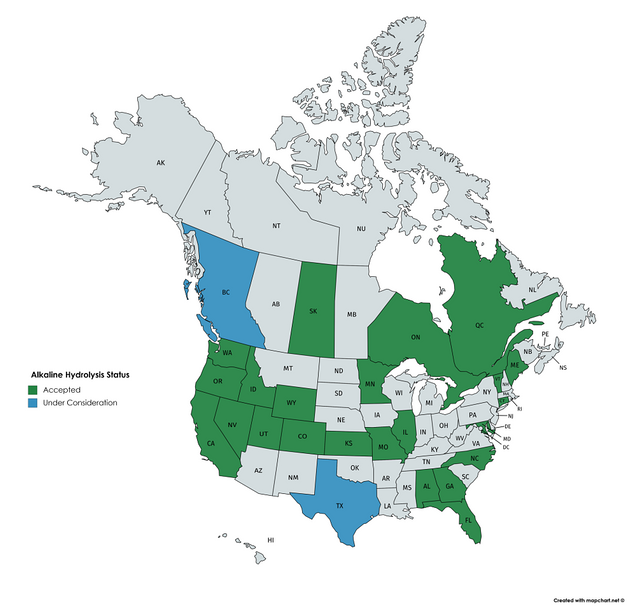 Figure 3. CANA keeps an up-to-date map reflecting alkaline hydrolysis regulatory changes.
Figure 3. CANA keeps an up-to-date map reflecting alkaline hydrolysis regulatory changes.
Once the wide-spread legalization of the process occurs, the public will likely push for greater access to greener cremation practices. It will be interesting to see if and when the process begins in Massachusetts and the remaining 30 states. In any case, the science shows that the massive carbon footprint that traditional burials and cremation services causes.
Tyler Heneghan anticipates graduating from Boston University School of Law in May 2021.


